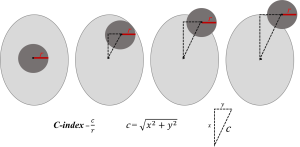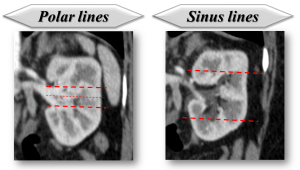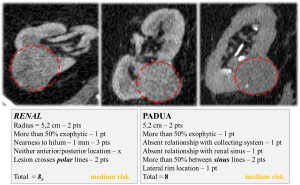RENAL Nephrometry Score
The RENAL nephrometry score, introduced by Kutikov and Uzzo in 2009, is a systematic approach to evaluate the anatomical complexity of renal tumors. The acronym "RENAL" encompasses the following parameters:
- R (Radius): Represents the maximum tumor diameter in centimeters, with larger dimensions receiving higher scores. (a radius of 4 cm differentiates a T1a lesion from a T1b lesion and, until recently, was considered the maximum dimension for partial nephrectomy).
- E (Exophytic/Endophytic properties): Describes the degree of tumor protrusion outside the renal contour or its extension into the renal parenchyma. Endophytic tumors, being more challenging surgically, are assigned higher scores (masses are not symmetrical, so use the most predominant feature in any axis).
- N (Nearness to collecting system or sinus): Denotes the shortest distance (in millimeters) between the tumor and the renal sinus or collecting system, with closer tumors scoring higher (the proximity to the collecting system is best determined on excretory images).
- A (Anterior/Posterior location): Specifies the tumor's position relative to the coronal plane, aiding in preoperative surgical planning (tumors that do not fall into one of these categories, such as a purely lateral or a central apical lesion, are assigned the designation “x”).
- L (Location relative to polar lines): Assesses whether the tumor is situated in the upper or lower poles of the kidney or near the hilar region, with hilar tumors generally being more complex (lesions that abut the main renal vein or artery are given the suffix “h” to define the hilar location).
This scoring system offers a standardized and reproducible method for classifying renal tumors into low, intermediate, or high complexity categories, facilitating treatment decisions and enhancing interdisciplinary communication [3].

PADUA Nephrometry Score
The PADUA (Preoperative Aspects and Dimensions Used for an Anatomical) score, introduced by Ficarra et al. in 2009, is a nephrometry scoring system specifically developed to quantify the anatomical complexity of renal tumors and aid in predicting the feasibility and risks of partial nephrectomy. It assesses six key parameters:
- Tumor Size: Tumors are classified based on diameter, with larger lesions receiving higher scores due to increased surgical complexity.
- Exophytic/Endophytic Properties: Measures the extent to which the tumor extends beyond or is embedded within the renal parenchyma, with endophytic tumors scoring higher.
- Renal Sinus Involvement: Tumors located near or involving the renal sinus are scored higher, reflecting their challenging surgical approach.
- Relationship to the Collecting System: Tumors closer to or involving the urinary collecting system are assigned higher scores due to increased surgical difficulty and risk of complications.
- Polar Location: Evaluates whether the tumor is located in the upper, middle, or lower pole of the kidney. Hilar tumors near vascular structures score higher.
- Anterior/Posterior Orientation: Indicates the tumor’s position relative to the coronal plane, aiding preoperative surgical planning.
The PADUA score provides a detailed and reproducible framework for classifying renal tumors into low, intermediate, or high complexity categories. Its application facilitates surgical planning, helping predict perioperative risks and outcomes [4].

SPARE Nephrometry Score
The SPARE (Simplified PADUA REnal) nephrometry score was developed to streamline the assessment of renal tumor complexity, building upon the existing PADUA classification. This simplified scoring system evaluates four key anatomical parameters:
- Tumor Size: Categorizes tumors based on their maximum diameter, with larger tumors assigned higher scores due to increased surgical complexity.
- Exophytic/Endophytic Properties: Assesses the degree to which the tumor extends beyond (exophytic) or is embedded within (endophytic) the renal parenchyma. Endophytic tumors, being more challenging to resect, receive higher scores.
- Tumor Location Relative to the Renal Sinus: Evaluates the proximity of the tumor to the renal sinus, with tumors closer to or involving the sinus considered more complex and thus scoring higher.
- Anterior/Posterior Location: Identifies the tumor's position relative to the frontal plane of the kidney, aiding in surgical planning.
By focusing on these four parameters, the SPARE score offers a concise yet effective method for classifying renal tumors, facilitating decision-making in nephron-sparing surgeries. This streamlined approach enhances clinical applicability while maintaining accuracy in complexity assessment [7].

C-Index Nephrometry Score
The C-Index, introduced by Simmons et al. in 2010, is a nephrometry scoring system designed to quantify renal tumor complexity based on the geometric relationship between the tumor and the kidney. Unlike other systems, the C-Index is a continuous numerical score calculated using tumor size and its proximity to the kidney's center of mass. The formula considers:
- Tumor Size: The maximum diameter of the tumor in centimeters. Larger tumors contribute to a higher score.
- Tumor Location: The shortest distance between the tumor's geometric center and the kidney's center of mass. Tumors closer to the kidney's core score higher due to their increased surgical complexity.
The C-Index integrates these parameters into a single score, providing a unique perspective on tumor complexity. A lower C-Index indicates a tumor with less complexity and likely suitability for nephron-sparing surgery. Conversely, a higher C-Index suggests a more challenging tumor, often requiring radical nephrectomy [8].


